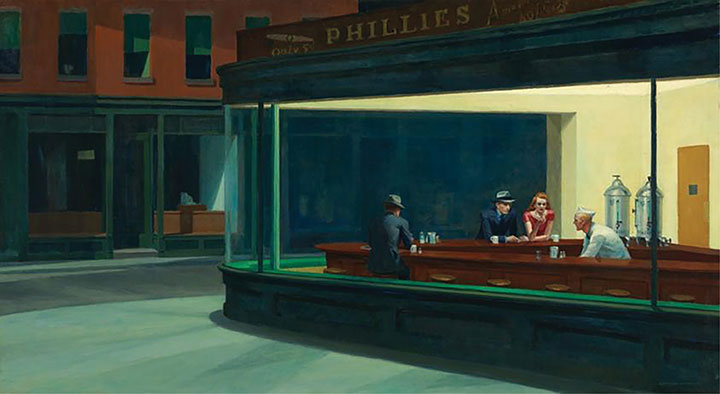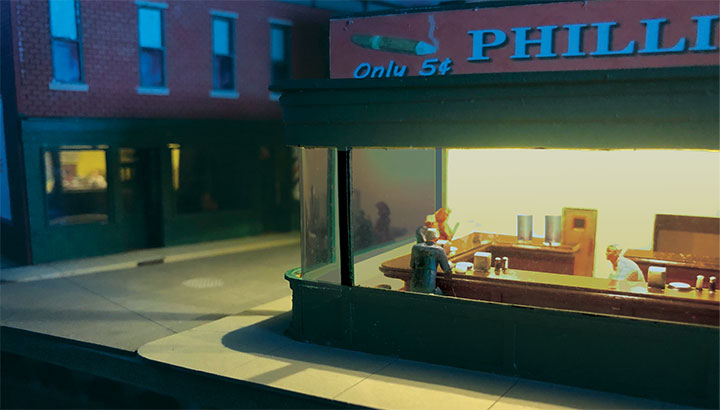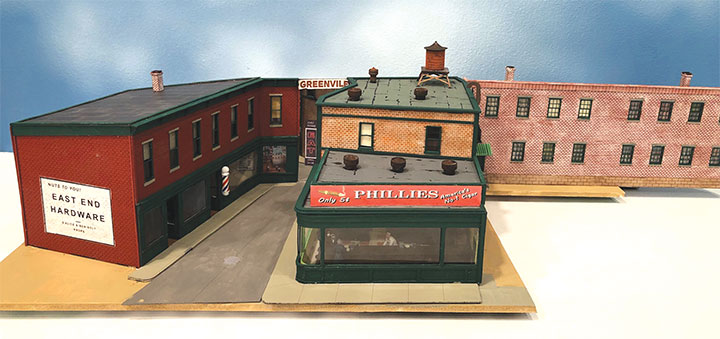Many years ago, John Coots, then owner of Scale Structures Ltd., claimed that model railroading was three-dimensional art. His observation was met with skepticism in an age which viewed our hobby as little more than grown men (and a few women) playing with toy trains. Still, he persisted and, in a way, proved his point by creating some stunning dioramas, one of which was displayed in the early 1970s at the Kodak Gallery in New York City.
I confess that I was, and remain, a skeptic of this model-railroad-as-art view, although I have visited model railroads that approach art. John Allen’s Gorre & Daphetid or George Sellios’ Franklin & South Manchester come to mind. Allen’s was an impressionistic masterpiece of an imaginary struggling mountain railroad and George’s marvelous layout depicts detailed urban scenes, both as good as any oil painting could capture. And as I often joke in speeches, layouts can be art though some resemble paintings of Elvis on velvet. It is the rare layout owner who claims his or her work is art and the rarer owner who would be correct in such a claim. Fortunately, for purposes of this column, I need not resolve this issue.
But intriguingly, a new manufacturer, Wit And Wisdom Models (https://www.wit-and-wisdom-models.com) recently advertised Nighthawks, a new kit in N, HO, S, and O scales, recreating a famous painting and a scene on John Armstrong’s O scale Canandaigua Southern model railroad. Now if the name John Armstrong sounds vaguely familiar, it should. Armstrong is widely recognized as the Dean of Layout Planning and his concept of Givens and Druthers are still used to scope planning. His home layout that Bob Brown and I visited in 1982 was a masterpiece of space allocation although Bob correctly remembers it as a maze. I too recall getting lost in the narrow aisles, despite admonitions in print by Armstrong to the contrary.
If Nighthawks also sounds familiar, you are correct. Edward Hopper (1882-1967) was an American realist painter famous for his depictions of urban life. Paintings such as Automat (1927), Chop Suey (1928), Early Sunday Morning (1930) and Nighthawks (1942) illustrate the loneliness and stark reality of New York in the early 20th Century. Interestingly, the buildings shown in Early Sunday Morning re-appear in the background of Nighthawks.
For model railroaders, Hopper’s House by the Railroad (1925) may resonate. It portrays an Addam’s Family style Victorian mansion on a hill above railroad tracks. But it is Nighthawks that I have always admired. This famous painting depicts a brightly illuminated imaginary diner at night with a few customers served by an attendant clad in white. All else is shrouded in darkness and the urban setting reeks of loneliness and alienation. It creates an instant mood. John Armstrong famously recreated this painting on his layout and now, Wit and Wisdom Models has done the same with this kit. As did Hopper, Armstrong took liberties with his interpretation. He imagined additional buildings not shown and cleverly maximized space by using bas relief ancillary structures, a mirror and reverse-lettered sign to create a depth not present. The kit faithfully does the same.
Wit and Wisdom owner, David Vaughn, explains that his goal was to honor and re-create Armstrong’s model more than Hopper’s painting, but in fact he has done both. Through this kit, you can capture the charm and appeal of Hopper’s Nighthawks in N to O scales which does elevate the model to art. Now what this has to do with the Narrow Gauge Scene is not really a stretch. The new NMRA Exhibit at the California State Railroad Museum in Sacramento displays an example. The P-B-L built Sn3 diorama, Chama, accurately portrays Chama, New Mexico’s, famous division point yard circa 1955. So where is the art in so doing? Well by necessity, the way the scene is presented, the use of color and the judgment needed to compress the scene while maintaining its integrity are all recognized artist’s tools. In doing so, P-B-L created art as do paintings of the same scene. Whenever a modeler creates a model, especially one based upon a prototype, there is an artistic application of color, judgment, and form. We have all experienced the impact of that when we admire the rightness of a scene or note how a modeler has captured the correct look of asphalt streets for example. Armstrong did the same with Hopper’s Nighthawks painting. His diner model with its Phillies Cigar sign and wooden counter captures the elements of the Hopper painting beautifully. He improved on Hopper, however, with completion of the scene by adding the imagined bas-relief buildings and mirror elements.



The kit which I assembled in HO, while not perfect, is masterfully done. Manufactured by Right Track Models for Wit And Wisdom and consisting mostly of laser-cut components, the kit enables one to recreate Armstrong’s model closely. Now to elevate the model to the Hopper painting level requires some extra effort beyond assembling the kit, but in my opinion that effort is justified. I hope I have done Hopper justice by using the painting as a guide to set the color, details, and lighting of the model. Here, you are pretty much on your own. The kit provides the framework and very faithfully provides the basics such as the diner components. Even the four distinctive figures of the painting are 3-D rendered accurately with additional unseen elements imagined. But you need to select color and add lighting based upon your own skills.
This is a complex kit and for a successful result, you will have to experiment and improvise a bit. The good design of the kit and illustrated instructions/parts list really help, as do the engraved part numbers. The use of Tichy plastic windows/doors in the HO kit and resin and 3-D parts also help tremendously. Armstrong’s design is a complex one with angled buildings and streets, so the model is intrinsically interesting even were it not replicating a famous painting. I generally followed the instructions but had to finesse the fit here and there. I also exercised judgment with the assembly steps. For example, the building attached to the diner features an impressive exhaust pipe on the diner back wall to be installed before trim is added behind it — obviously it should be done the other way around. I moved the pipe slightly as it made no sense attached to the diner. I also added CC Crow seamed tarpaper and extra vents to the roof plus a railing around a fire-escape platform. A modeler’s eye and common sense for what looks right are part of the Art of Model Railroading.
The complex layered curved design of the diner was a real challenge. To smoothly bend five layers of laser board/acetate to a sharp curve while keeping everything aligned was almost impossible. Indeed, I tried two or three times before getting it right and even then, it is not perfect (Hint: use the roof curve as a template). I found pre-painting and aligning all the layers first before curving and gluing them as a unit, was the best approach. Clamps and fingers were needed to coax the layers into alignment especially when the roof was added. The design of the kit really helps here. By far the diner is the fussiest part of assembly but worth the effort. If done right, it is spectacular. The full interior adds to the effect with some out of painting elements such as a cash register. I even added a wall menu and a recycled Plasticville porthole door to the diner rear wall as the painting does not indicate how the customers gain entry. Overall, the kit is superb at rendering this diner just as shown in the painting.
Surprisingly, as mentioned, no color recommendations are made, nor is lighting addressed in the instructions or provided. Using the painting itself, I chose some widely available craft paints that came very close to the colors used in the painting. I used Delta Ceramcoat’s Pale Yellow for the diner interior, Hunter Green for the diner exterior and building windows/trim, as well as various shades of brick color for each building. I applied Roberts Brick Mortar to two buildings but not to the one across from the diner, again to match the painting. Similarly, I painted the provided figures to match the colors in Nighthawks as best I could. The female figure’s head was mis-printed, and I swapped heads with another figure in my collection. Her distinctive red hair was serendipity. I used Dr. Microtools brand modeler’s putty to recreate her flowing locks and its red color was perfect without paint. Lighting consists of four Woodland Scenics’ LED lights in the diner and a few more elsewhere. Note the attached building’s recessed-entry ceiling has a hole for a light which I added. Matching the light/shadow mix of the painting is frankly impractical but the very bright diner and dark adjacent buildings at least approach the effect.
Assembly of the remaining buildings was much more straightforward. On the bas-relief building, I did install the Tichy frame windows reversed and upside down, as brick building windows would not have a frame. I created sills/lintels of thin wood painted concrete color. I also added an awning over the door, window treatments and two lighted rooms made of a room interior graphic in a home-made lightbox. The last building is partly featured on Nighthawks, so I tried to replicate the look as much as possible. No lights were added as darkness is part of the effect. Again, the frame windows were installed backwards with concrete lintel and sash added along with green paper shades. I also added a neon window sign to the last storefront (which is out of the picture) and a few rudimentary interior details for the hardware store and barber shop (which are pictured). I chose a brick color and Hunter’s Green for trim to match the painting. The roof comes with engraved tarpaper squares and only needs painting. With that and the addition of the street/sidewalks and mirror, the kit was complete. I did not use the extended cornice over the mirror (which made no sense since there is a street reflected) but did use a “banner” sign to disguise the top of the mirror.
When put together on a base and lit, I was thrilled to have captured the essence of Nighthawks with an urban model that itself is significant as an artifact of John Armstrong. If placed on an elevated site using the dramatic lighting inspired by the painting, visitors will understand that by gosh, model railroading is art.
Well, that’s all for now: until next time — write, if the mood strikes.